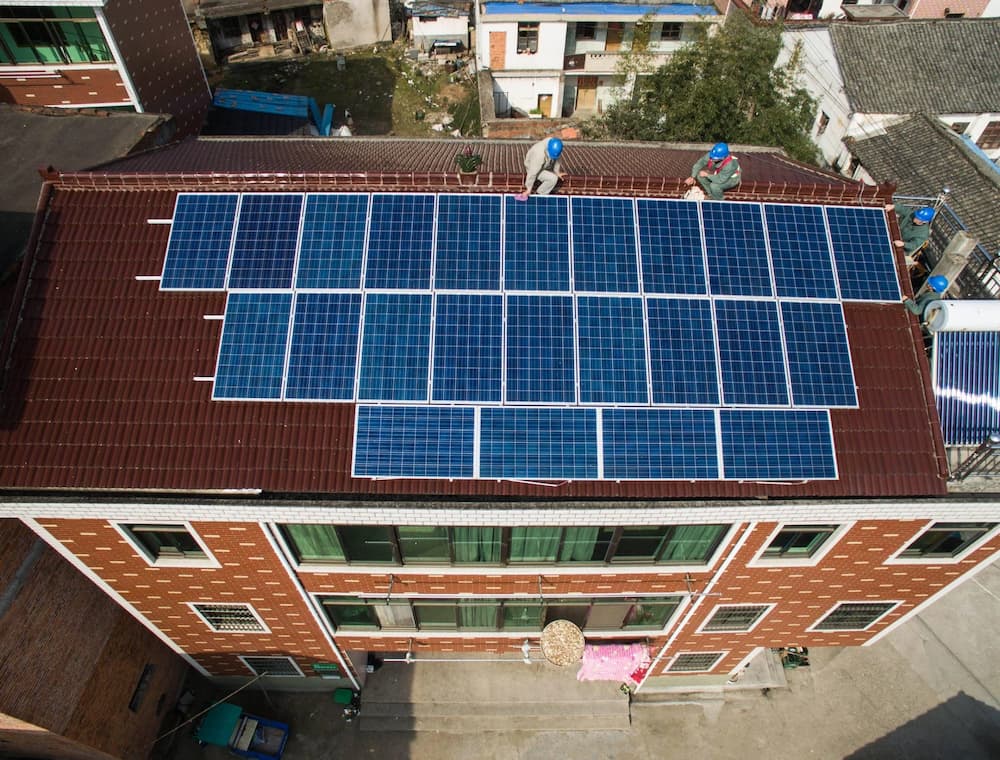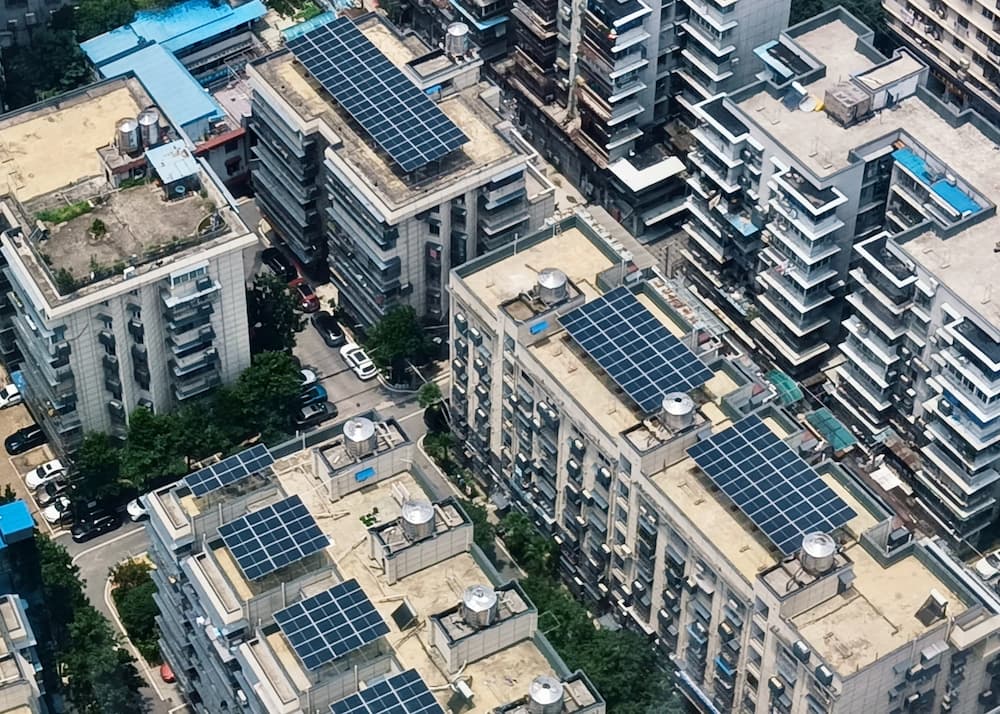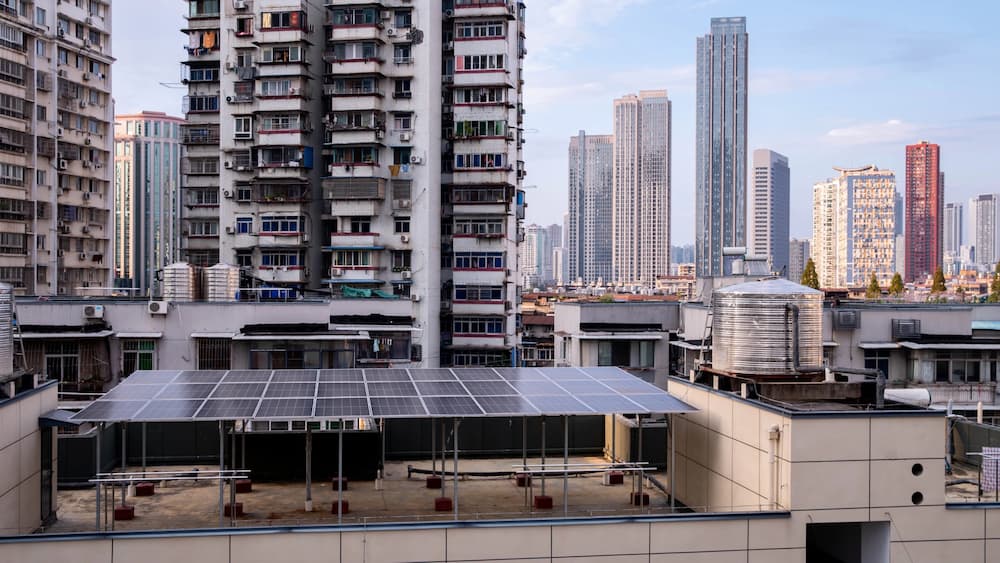A community’s project suggests emissions-reduction work must benefit everybody to succeed, writes Gao Baiyu.

Technicians test solar panels on a residential building in Yiwu, east China’s Zhejiang province. In Hubei province’s Wuhan, residents of Beihu have assigned their rooftop solar rights to a power firm. In return, they get a large discount on their service charge and improvements to their communal rooftop space (Image: Xu Yu / Xinhua / Alamy)
The Jianshe apartment complex in Wuhan’s Beihu subdistrict is a striking juxtaposition of the old and the new. These buildings in central China are of varying heights and some date back to 1987. Three are dotted with solar panels that together cover about 550 square metres – the size of a basketball court.
So far, the 126-kilowatt installation powers amenities including hallway lighting, street lights and LED displays. The plan is to also hook up 19 electric-vehicle chargers, four “smart waste” receptacles and a charging dock for electric bikes.
The Jianshe management body has overseen the installation itself, meaning the power is used in-house and any surplus can be sold back to the grid.
The project has benefitted from the support of a global mayoral network called C40 Cities, which this author works for, as well as the local authorities of both Wuhan and Beihu.
The complex is almost carbon-neutral, but the panels haven’t just cut carbon emissions. They have provided sheltered areas in communal rooftop spaces, among other benefits. The arrangement has worked for the community, individual residents, and the solar-power firm involved. Other old apartment complexes could benefit from similar arrangements, people involved in the project have said.
How does it all work?
Jianshe’s residents have assigned their rooftop-usage rights to an external solar-power company. It is responsible for funding, operating and maintaining the panels, and selling the generated electricity at a profit. In return, the Jianshe management body gets electricity at half the commercial rate – CNY 0.50 per kilowatt hour – lowering the residents’ service charge.

“The rooftop solar means we’re not paying for communal electricity use,” says resident Wang Shufang. “We’ve got more amenities in the community, and the rooftop spaces are more pleasant.” (Image: Beihu Subdistrict Office)
This saves Jianshe almost CNY 50,000 (USD 6,900) annually, which goes into a communal fund dedicated to solar-powered lights, rainwater-collection equipment and planters for a rooftop garden. The solar panels also help keep the rooftops cool and dry – another advantage for the residents, who use them as a communal space. “The rooftop solar means we’re not paying for communal electricity use,” says resident Wang Shufang. “We’ve got more amenities in the community, and the rooftop spaces are more pleasant.”
The panels are managed by Fengmai Energy, which says Jianshe generated 76,300 kilowatt hours of solar power in the 12 months from early April 2023. In other words, the apartment complex avoided indirectly emitting 99.3 tonnes of carbon dioxide and 12.1 tonnes of ash, according to the company. Assuming a 25-year lifespan, the installation will generate a total of 2.5 million kilowatt-hours of electricity and avoid burning 744.8 tonnes of coal, states the company.
A difficult road
Unlike a new apartment complex with pre-installed rooftop solar, the Jianshe community had to navigate bringing all residents on side. This proved especially tricky because there are currently few examples of new, successful rooftop installations on old buildings.
China’s housing regulations are such that the roof of an apartment block is communally owned by all residents. That means there must be unanimous agreement to install solar panels there, making this a far more complicated undertaking than doing the same atop a public, commercial or agricultural building.
Another hurdle is deciding who receives the generated power, how it should be used and how any profits should be split. Li Zhong, Jianshe community’s Communist Party secretary, says several proposals were floated before a final decision was made.
The first was for the Beihu authorities to manage the entire process. This would have led to putting panels on every roof in the complex to maximise generation, but Li says the economics of that proposal’s setup costs, lifespan and payback periods “didn’t make sense” – even if installations were limited to the roofs with the best sunlight.
Why should the residents be in favour?
What they want is actual benefits they can see and feel.
- Li Zhong, Jianshe community’s Communist Party secretary
The committee’s plan B was a 50:50 government–business partnership, with panels only installed in the sunniest locations. “That meant we would just break even,” says Li. “The government, however, wanted to get its return on its investment first, meaning the business partner would need to wait. That put the business at greater risk of issues such as residents changing their minds, so the proposal didn’t work out.”
While considering those two plans, the community fielded ideas from government, businesses, residents and thinktank experts. Gradually, the consensus changed. “Doing solar on communally owned residential rooftops needs to be both profitable and socially beneficial,” explains Li. “In other words, what do the residents get? Why should they be in favour? What they want is actual benefits they can see and feel.”
It was ultimately decided that the project would be outsourced to a private company. The management committee signed over the running of all electricity-powered amenities to the solar-power firm, which uses the power it generates to run them. The panel positions were no longer primarily determined by size or sunlight, but by causing the least impact to residents’ use of the rooftops. The bulk of the roof space has been saved for residents to use and is in fact now more pleasant, because the panels provide shelter from the weather.
“The panels help protect the roof,” says Wang. “We used to have leaks, but not now. And now we can go up for some fresh air, or to dry clothes, even when it’s raining.”

Drying racks have been placed under the panels for residents to use (Image: Beihu Subdistrict Office)
Will it work elsewhere?
Jiang Jingjing, manager of C40 Cities’ Green and Thriving Neighbourhoods project, says such community pilots can inform larger-scale rollouts of new urban policy: people-centred projects like Jianshe’s could help speed up carbon neutrality and sustainable development in cities.
But there is a long way to go before wider rollouts of similar projects. Participating communities, residents and businesses must first have the same low-carbon vision and willingness to work together. Neighbourhood committees must persuade residents to sign over usage rights to their communal rooftops, and business partners jointly agreed upon. A lot of complex communication and coordination is needed.
Many residents of apartment complexes naturally worry about safety, or the risk of water leaks. Another misgiving to navigate is the idea of solar panel radiation. In Jianshe’s case, the neighbourhood committee had to tackle these concerns several times.
“At first, we didn’t understand,” says Wang, “but the Party secretary explained things and took us to a solar power pilot project with a Geiger counter to show there was no radiation. After that, we started to think it could work. There wouldn’t be any noise, there wouldn’t be any drawbacks, and it would bring benefits.”
“The committee did a very good job on the presentations, consultations, and signing everyone up,” says Li Zhongjie, another Jianshe resident. “It was open and transparent, and we are all very supportive.”
A cooperative business partner is also invaluable. Shen Peipei, a project manager with Fengmai Energy, says a solar-power installation can last 20 years, and it takes around 15 years before such an installation turns a profit. “But there are both social benefits and commercial profits here,” Shen adds. “This project is part of our corporate-social-responsibility work. If any other communities want to set up similar projects, we’d be happy to work with them”.
Zhang Huijun, who directs the Beihu subdistrict office, says Jianshe’s success story was already having an effect elsewhere, in both Beihu and wider Wuhan. “Firstly, the state is already working on upgrading older communities and we can build green and low-carbon ideas into that process,” she says. “Secondly, the public can really see the benefits of solar power, which means they’ll be more supportive. Thirdly, we need to get the residents involved, as well as private investors and businesses, creating a triple-win.” She says the subdistrict office will continue to facilitate the decarbonisation of energy by cooperating with C40 Cities, and promoting rooftop solar for established residential communities like Jianshe.
This article was originally published on Dialogue Earth under the Creative Commons BY NC ND licence. Read the original article.


